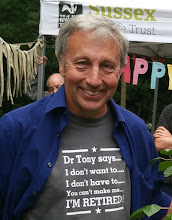I was very pleased to attend the CPRE conference entitled
“Future Proofing Sussex” last Saturday.
In general the Sussex Wildlife Trust and CPRE are tending to work even
closer together these days so it was good, if worrying, to hear some excellent
presentations on the development threats that Sussex
is under.
In particular Roger Smith, Chairman of CPRE’s Horsham
branch, exposed some very important issues that we should all worry about.
Much of our countryside is unprotected. In the language of developers this means that
it is unconstrained – locations ripe for development. Indeed even that which is protected in some
way can still often be under threat.
We have housing needs, and figures are always marshalled to
show how we must “predict and provide” in order to meet these needs. Even though they are accepted unquestioningly
by the media, such figures are often extremely dubious, but this is not the
element I wish to point out here.
The South East Plan was revoked this week. I was no fan of the SE Plan so you may think
I’d be pleased. The plan imposed
top-down figures for how much housing had to be built. Local Authorities simply had to do their duty
and find locations for the dictated housing. This inevitably bred conflict and the incoming
coalition government vowed to make the situation much more locally led.
This clearly is the intention of many politicians of all
shades, and it was good to hear MP Nick Herbert
at the same conference speaking strongly in support of a locally led approach.
Roger Smith’s presentation, however, showed that we should still
be concerned.
Many in government are very pro-development. They still push for the availability of a 5
year supply of land for housing, to house a growing population or drive
economic growth or whatever. All the
presumptions about house building can be questioned but these “needs” for
development are still pushed down from above.
So Local Authorities still have to identify land for
housing. How much land must they find and
where do they go for figures on this? You've guessed it – the South East Plan!
It would appear that the top-down approach to housing
numbers remains, even after the plan has been revoked. The Planning Inspectorate may therefore still
consider the house building targets set in the SE Plan to be the yardstick by
which they assess housing numbers put forward by Local Authorities.
The South East Plan is dead – long live the South East Plan!
We may end up with the worrying worst-case scenario where
all the best parts of the South East Plan have been revoked (the policies for
environmental enhancement, the protection of our natural assets etc) but all
the worst parts are still just as strong as they were before.
But it gets worse.
Developers are sitting on hundreds of permissions - land
where they already have permission to build houses. They are not building them because they can’t
sell them and this is part of the reason why housing figures are not being
met. Nevertheless developers still claim
they need more land to build more houses even though they are not building on
land where they already have permission.
Could it be that developers are banking large numbers of permissions so
storing up a wave of development for a future date when they feel they can sell
houses again?
So we can look forward to another house building boom where
the few remaining fragments of the Sussex
countryside are built on. But at least
it means everyone will have a house.
Well will they? I’ll finish with
a silly statistic.
A main drive to the need for housing isn't just population
growth or immigration; it is a trend for there being fewer people per
house. Fewer people per house – so you
need more houses. If we guess the rate
of reduction of household size (there were about 3 people per house in the
1970s, there are about 2.5 people per house now) and extrapolate forward then
you get to a point in about 250 years when the graph crosses the zero line -
nobody will be living in any houses no matter how many you build – and people
will still be homeless! This shows the
fallacy in adopting statistics and trends unquestioningly.
